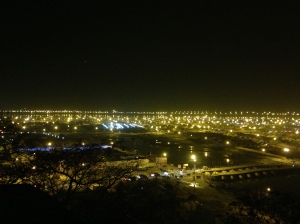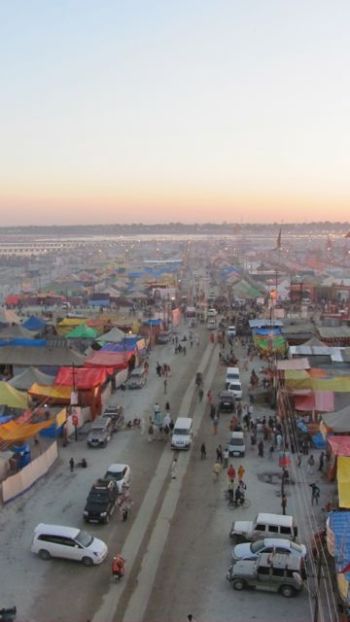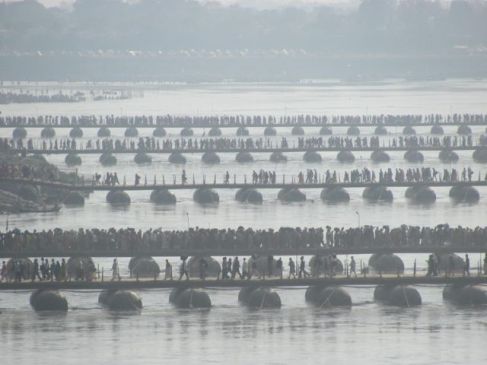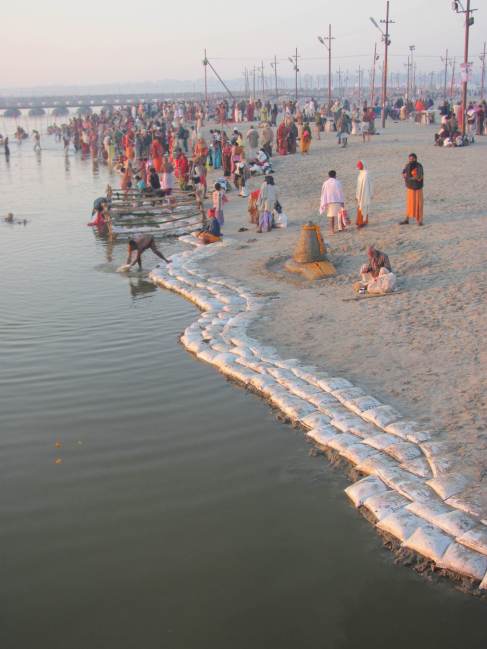Archive for the ‘Health’ Category
NY Times Blog on HSPH Project
Can Big Data From Epic Indian Pilgrimage Help Save Lives?
Big data, meet humanity.
The South Asia Institute at Harvard has sent a team of public health specialists to one of the largest gatherings in the world, the Kumbh Mela in India, with a goal of assembling the largest public health data set ever among a transient population.
The Kumbh Mela, a religious festival that is expected to draw nearly 100 million pilgrims, is in full swing … [READ MORE]
Waiting for an Uneventful Day
February 9, 2013:
The crowds in the Kumbh Nagri have swollen to fill the sandy Gangetic floodplain as the largest bathing day begins tomorrow. Today the roads brimmed with pilgrims on their way to and from the Sangam; the barricades rolled to block all vehicular traffic from entering the City. A great deal of attention has been paid to developing infrastructure that can both accommodate and control the movements of cars, lorries, rickshaws, bicycles, motorcyles, and millions of people.
The streets at the Kumbh Nagri are wider than those in most Indian cites. The major thoroughfares can easily hold four or five standard lanes of traffic. Although the road margins are periodically obstructed by celebrants lining up crossed-legged to receive Prasad or by the ubiquitous informal merchants displaying wares on ground cloths, there is no encroachment of the semi-permanent structures of the camps onto the road. The size and uniform width of these thoroughfares provide an ostensibly bottleneck-free area for the movements of people going to bathe at the Sangam.
At each major intersection moveable metal barricades manned by police can rapidly shunt the flow of traffic away from a particular area and generate unidirectional flow. These barricades typically control auto traffic only, but could in theory be used to move people away from a highly congested area with stampede potential.
Walking to the Sangam from the east bank of the Ganga one crosses the river on a dense network of pontoon bridges. Because the bridges are only wide enough for one lane of auto traffic flanked by two narrow sidewalks, major roads with bidirectional traffic split to traverse the river on 2-3 bridges each. A network of barricades and pikes control flow onto the bridges. Auto traffic is unidirectional but pedestrians so far are allowed to move in both directions. The bridges represent bottlenecks compared to the generous width of the roads. The western bank of the Ganga has a flat and gradual slope but the eastern bank is a 10-20 foot escarpment of sand that drops abruptly into deep and fast moving water. There is obvious potential for drowning in the event of a stampede. Post and rail fences and cuts through the earth of the embankment that funnel the crowds onto the bridges attempt to mitigate the dangers posed by these natural obstacles.
At the heart of the Sangam on the west bank of the Ganga, the land gently slopes into the water. As one nears the bank, straw blankets the ground for approximately 30 meters to provide traction for millions of wet feet as they return from the holy waters. Getting nearer the water, the straw gives way to sandbags lining the river’s edge for 1-3 meters for the length of the major bathing areas. The sandbags are placed to prevent erosion and stabilize the bank, but they also have the effect of solidifying the sand for the crush of people waiting their turn to enter the water.
The river currents are treacherous, swift and changeable as the Ganga merges with the Yamuna and the water deepens precipitously as one walks from the water’s edge into the depths of the river. Periodically positioned spurs of sandbags serve to break the swift current into safer eddies for the bathers. Poles sunk into the mud and connected by cordons demarcate the deep water where hired rescue boats bob in a state of constant alertness.
Outside one of the main entrances into the Kumbh, where city roads meet Nagri roads, crowds are to be diverted into a massive corral spread over five to seven acres, where they will be encouraged to follow winding paths demarcated by bamboo fences. Some locals fear that the visitors may simply jump through the fences and attempt to cut straight through the field.
All roads leading to the Mela, and for several kilometers around, have been shut to vehicular traffic. The paths to the Sangam are packed, the bridges are full, and the sidewalks lined with sleeping pilgrims. Millions will soon descend upon the confluence for their holy bath. The atmosphere in the administrative offices is tense. The wide roads, the winding corrals, the sturdy bridges, the sandbag spurs, the rescue boats and the mounted police are in a heightened state of readiness. Long months of deliberations, design and implementation have been invested to make this one day as uneventful as possible – as uneventful as the world’s largest human gathering can be.
Michael Vortmann
FXB Team Back at the Mela
February 5th
Today, the second team from the FXB Center for Health and Human Rights arrived at the Kumbh Nagri to continue to study the public health implications of the Kumbh Mela. The public health team that visited the Mela along with the rest of the Harvard contingent in January had initiated a disease surveillance system at the sector hospitals serving the pilgrims visiting the Kumbh. This ambitious undertaking piloted at four of the 10 sector hospitals hopes to capture, in real time, the epidemiology of diseases presenting at the healthcare facilities at the Kumbh Mela. The project is implemented locally by a large network of medical students from across India, who, for the past several weeks, have been diligently recording data from patient registries into their iPads. Navigating bumpy roads, traffic jams, long distances, inclement weather, and reticent physicians (sometimes enthusiastic, often times reluctant, and always overworked), our medical students are having “a time of their life.” They said so themselves – over chai and halva – as we exchanged notes against the tintinnabulation of the evening’s aartis rising simultaneously from the many akharas beyond our fence.
We met with Aaron, Ahmed, Ghanshyam, Raunaq, Aditi and Shrunjal. After a 10-hour work day, a stalled motorcycle, and a 10 kilometer walk, they looked upbeat, excited, and were bubbling with ideas. Most of them are on the cusp of graduating from medical college, having just passed their boards, or about to take them. Their interests are diverse, ranging from psychiatry to critical care, yet what brings them here is a spirit of adventure and a commitment to service. “I would never have thought of coming to the Kumbh, were it not for this project,” said Shrunjal, “and I am glad I did.” They did not all know each other before this trip, and now they have learned to share a heating coil to heat up their bath water, learned how many snooze alarms it takes them to get out of their beds in the morning, and learned how to cajole the overworked physicians at the sector hospitals to write more legibly. Aaron, the New Yorker amongst them, and supervisor-at-large, has the best local sense of direction.
This evening, after settling into our rather comfortable tents perched on a small hill overlooking the Nagri (as had several members of this team, in the weeks preceding us), we walked over to the observation patio that overlooked the Sangam. I had visited the Nagri in the early days of December when it was under construction: endless rows of lusterless electricity poles marked a grid on the shifting banks of the Ganga, a few saffron flags fluttered impatiently in the evening breeze, important looking jeeps circled the empty plots unable to decide on a final location to pitch camp, and the final pontoons were being lowered into the water on the far-side. I had imagined what it would be like once the Mela started: saffron robed sadhus, pious pilgrims, loud chanting, incense, beads, flowers, and the holy dips. But I had imagined it in the light. This evening, I saw it in the dark.
From where I stood, all I could see – for as far as I could see – was a sea of golden lights, a million Diwali lamps lighting up the world’s largest fair.
Tomorrow, our team informs us, is an important bathing day: Ekadashi Snaan. Roads may be blocked, and millions may throng to the banks for a holy dip. Unfazed, we plan to venture out to visit the sector hospitals, the fruits of our teams’ labor in hand. The diligent work done by the medical students from Allahabad, Mumbai, Nagpur (and New York and Boston) has allowed us to create daily graphs of the frequency of medical complaints or diagnoses presenting to the hospitals under study. Tracking the frequency of diseases over time will allow us to understand and question deviations from the expected trends. Does an acute rise in incidence indicate a jump in the population or does it portend an epidemic? Can outbreaks be predicted in this setting before they occur? What ailments does this population most suffer from? Is some part of the burden of disease preventable? Tomorrow, we will present our analyses to local physicians hoping that they may pause and reflect on the enormity of their contribution. In ten days, over 12,000 patients have passed through four sector hospitals, as many diagnoses have been made, and over 15,000 medications have been dispensed.
The questions compete in number only with the bustling hordes of Kalpavasis coming to the Nagri: Who protects the health of this population? How effective is the water purification? How effective are the pit latrines? How is the sewage treated? What if there is an outbreak? What about the children? Where do they go if they are lost? Who cares for them? How are they found? Are they found? What about the elderly? The infirm? What if there is a stampede? A fire? A collapse?
The list is long, our time is short, but the opportunity to ask and answer, to seek and find, is priceless – as is the rhythmic beat of distant dumroos rising from the valley as they now lull our jet-lagged souls to sleep.
Tomorrow, will be our first day at the Kumbh Mela. Tomorrow we will see the Sangam.

On Pilgrims and Refugees: A Comparative Reflection Susan Holman, Senior Writer, Harvard Global Health Institute
How does the Kumbh Mela compare with a refugee camp? I found myself reflecting on this question in our research project on the Kumbh Mela during a bumpy ride on Monday through “Sector 7,” the northmost tract of the fairgrounds. I am participating in the Harvard Kumbh project as part of the Harvard Global Health Institute (HGHI), a university-wide institute under the Office of the President and Provost. As a co-sponsor for the Harvard Kumbh project, HGHI provided funding for faculty and students from the School of Public Health, the Divinity School, and the College; course support for the fall 2012 Kumbh Mela Workshop co-directed by Professors Mehrotra and Eck; a resource portal on its website as part of its focus on urbanization and its effects on global health; and ongoing collaborative development of educational public goods.
The Kumbh’s Sector 7 is a vast flatland, where wandering pilgrims, workers, and all-terrain vehicles wind their way across the mud-and-metal-plate road and between a medley of corrugated metal and temporary frame huts and tents. It is miles away from the flashy, carnivalesque akharas; even the holy river is barely a glimpse in the distance. In such a setting, what can the Kumbh Mela teach about temporal urbanism that might help improve responses to humanitarian emergencies and refugee settlements?
After four days at the Kumbh, experiencing this amazing event very much as a subjective encounter, it strikes me that the Kumbh Mela radiates with at least three elements that seem characteristically very different from conditions in urban emergencies, worth considering in developing discussion on this unique liminal space:
1) “Mood.” This was undergraduate Isaac Dayno’s instant response to my wondering aloud about these differences as we bumped along in the van. There is an atmosphere of energy. Everyone is excited to be here, to use this temporary opportunity for good, whether spiritual or material. As the land waits, and construction continues for the millions still to come for the major bathing days, there’s a buzz in the air. This is true even though people are living in conditions that often look to me very much indeed like those of refugees. And yet their focus is religion. It is religious meaning that is at the heart of this mood, the very pulse of this temporal urbanism.
2) Committed governance. The whole shebang is funded and supported by the local and state government. Public commitment to governance is everywhere: police sit prominently at all the road junctions. Tractor-drawn water trucks keep the dust down. Corrugated tin latrines are marked by prominent signs every few hundred yards. A daily truck ploughs through the roads emitting a cloud of insecticide in its wake. I haven’t seen a mosquito yet (and yesterday actually watched a fly die). Workers in dun-colored garb and official caps trudge along carrying round wicker baskets that, dropped at intervals, mark the road with mandala-shaped impressions of a white antiseptic powder. Of course this process is not perfect. But there is high motivation for a public show.
3) Profit. Unlike urban crises, where refugees come as “losers,” pilgrims come to the Kumbh by choice. The religious, government, and medical officials come because it is expected, and though they are on call 24/7, both the mood and governance processes generate a confidence in a happy outcome to the event. Everyone comes expecting to receive something profitable—be it holy water, release from reincarnation, a blessing, or market profit. The patronage and gift exchange is liberal—and consciously time-limited. Even the most devout pilgrims who arrive on foot, with nothing more than the clothes on their back, will go home again. Even when the river rises once again, closing over the grounds with its sacred flow for another year, everyone knows the festival is not over: it merely waits for next time.



